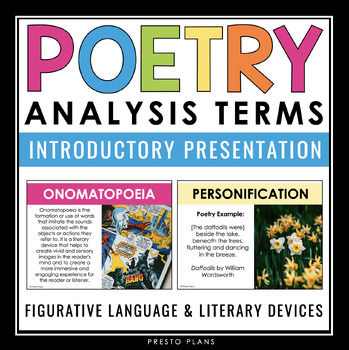Poetry Terms Figurative Language Introduction Presentation for Literary Terms
- Zip
What educators are saying
Also included in
- This poetry unit resource bundle is a collection of my most popular and best-selling poetry analysis and writing resources! Make poetry fun for your students with this huge bundle that contains over 470 slides and pages of creative and engaging poetry resources that will save you hours and hours ofPrice $49.99Original Price $85.83Save $35.84
Description
Use this poetry terms presentation as an introduction to figurative language and literary devices commonly used in poetry. This is a must-have resource if you are introducing your poetry unit as it reviews the most commonly used poetry terms, literary devices, and figures of speech used by poets. After using this slideshow, your students will feel totally confident identifying and analyzing literary devices used in the poems they are reading. The poetry terms presentation guides students with detailed definitions of the poetry devices and examples from real life and from poetry. A notetaking template is also provided, so student can have a reference to use during the poetry unit.
This is included in our best-selling poetry bundle
Included in this poetry terms presentation resource:
➡️ A 26-slide PowerPoint presentation that provides the definitions for 13 of the most common poetry terms, figures of speech, and literary terms used in verse. The slideshow also includes real-life and poetry examples of the device in use. Below is a list of the literary devices included in this figurative language presentation:
- Alliteration
- Assonance
- Consonance
- Hyperbole
- Metaphor
- Onomatopoeia
- Oxymoron
- Personification
- Pun
- Simile
- Imagery
- Symbolism
- Synecdoche
➡️ A note-taking template that students can complete as you go through the figurative language presentation. The literary devices are listed, and students must include a definition and an example based on what they learn in the figurative language presentation
➡️ Print the poetry terms definition slides and post them on your wall as classroom posters! They look great on display as a poetry bulletin board.
What teachers are saying about using this poetry annotation resource:
⭐️⭐️⭐️⭐️⭐️ This was such a good resource for my Writing Comp students! It worked really well and kept my kiddos engaged! Will definitely use again next year!
⭐️⭐️⭐️⭐️⭐️ Used this in pairing with an EngageNY Unit, and this was a great and visually appealing review resource for my high school students. Thank you!
⭐️⭐️⭐️⭐️⭐️ I used these before I started a poetry unit with my class. The best thing about them is the examples provided. The examples made the definitions much clearer and helped my students understand the terms. The examples are also clever.
Pair this poetry terms presentation with our poetry annotation guide:
→ How to Annotate Poetry Student Guide
© Presto Plans
➡️ Want 10 free ELA resources sent to your inbox? Click here!
⭐️ Follow Presto Plans on TpT to see what's new and on sale.






